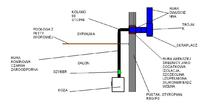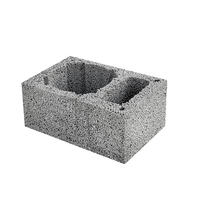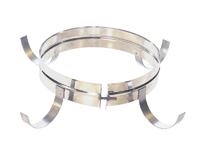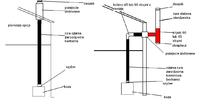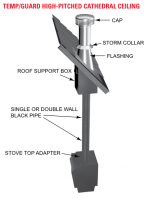Hello, I want to put a stove-stove (cast iron, decorative) in a summer house (brick) in allotment gardens. House of about 50 sq m, living room and upper bedroom. The ceiling and the bedroom floor are made of beams and chipboard on it. The goat is to be placed against the wall in a central place. I do not have a chimney and therefore I have a few questions. Maybe you can help. I also mean the lowest possible cost
If anyone is able to answer any question and share knowledge and experiences, I would be very grateful
1. What kind of pipe should be used as an internal chimney, does it have to be a pipe for the fireplace, such a black one, it costs about PLN 80 per meter or can some other be used? (it would be nice if it was cheaper and dark because the dark cast iron goat).
2. Can you walk through the wall in the living room or can you get to the bedroom through this chipboard and then outside? The cost of a double-walled pipe to be outside is greater, so I thought that I would only go out in the bedroom to reduce the section of this double-walled pipe and I would regain more heat
3. When it comes to insulation, I would like to put up such a red brick wall so that the wall that is now (regips, brick) does not heat up, it is enough to insulate the wall? I don't want to play with some wool and foil insulation and finish it somehow later
4. Is it enough to make a larger hole in the place where the pipe will pass, to insert a double-walled pipe into it and to fill the gap between these pipes with silicone resistant to higher temperatures?
5. If I go outside, do I have to give the elbow only or do I have to give the tee? (there would then be two elbows, one inside and one outside). An insulated tee is quite expensive.
6. Maybe you can do external insulation yourself? But how?
If anyone is able to answer any question and share knowledge and experiences, I would be very grateful
1. What kind of pipe should be used as an internal chimney, does it have to be a pipe for the fireplace, such a black one, it costs about PLN 80 per meter or can some other be used? (it would be nice if it was cheaper and dark because the dark cast iron goat).
2. Can you walk through the wall in the living room or can you get to the bedroom through this chipboard and then outside? The cost of a double-walled pipe to be outside is greater, so I thought that I would only go out in the bedroom to reduce the section of this double-walled pipe and I would regain more heat
3. When it comes to insulation, I would like to put up such a red brick wall so that the wall that is now (regips, brick) does not heat up, it is enough to insulate the wall? I don't want to play with some wool and foil insulation and finish it somehow later
4. Is it enough to make a larger hole in the place where the pipe will pass, to insert a double-walled pipe into it and to fill the gap between these pipes with silicone resistant to higher temperatures?
5. If I go outside, do I have to give the elbow only or do I have to give the tee? (there would then be two elbows, one inside and one outside). An insulated tee is quite expensive.
6. Maybe you can do external insulation yourself? But how?



